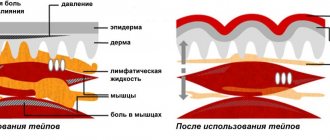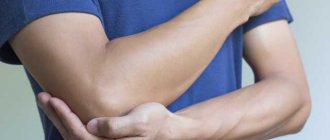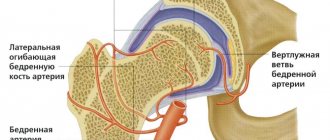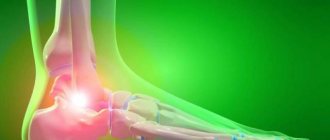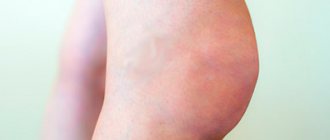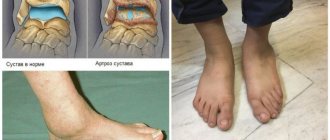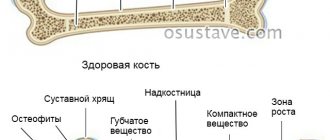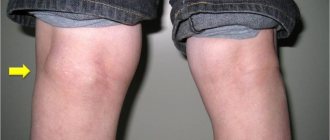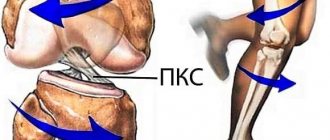Neurological diseases at the initial stage may pass without pronounced symptoms, but in an advanced stage they can cause irreparable consequences.
Severe pain in the shoulder joint may indicate a pinched brachial nerve, so you should definitely visit a doctor. If you neglect the problem or delay a visit to a neurologist, it can develop into vertebrobasilar insufficiency.
Therefore, at the first pain in the shoulder area, contact the specialists of the Kuntsevo Center. Our diagnostic base allows us to quickly conduct an MRI of the shoulder, ultrasound or electroneuromyography, based on the results of which the doctor will select the optimal treatment for the disease.
In addition, by contacting a rehabilitation center, you will save your precious time: here you can undergo diagnostic procedures, get advice from doctors, and also receive qualified recommendations for recovery.
Dozens of patients have already been able to verify the individual and effective approach of the treating staff to solving the problem of shoulder pain.
Pain by severity
A person can feel pain of varying intensity:
- Aching (also called somatic) - they appear rarely, it is difficult to establish the exact localization, and can last for days. Most often it occurs in bones and joints, causing a person a lot of inconvenience and discomfort.
- Acute - occurs unexpectedly and with high intensity, and can pass just as quickly. It is the first sign that brachial neuralgia is developing.
- Chronic – constant inflammation of tendons and joints causes the formation of chronic pain.
Pain by mechanism of occurrence
Evidence of problems with the cervical vertebrae is pain that is felt from the shoulder to the fingertips. In some patients, the arm may go numb for some time.
When you raise your arm and at the same time feel discomfort, you can talk about a problem with the supraspinal tendons.
There is another type of pain in the shoulder - when doing loads or physical exercises, the biceps hurts. This indicates a problem in the forearm.
Treatment for pain in the shoulder joint
When complaining of pain in the shoulder, the specialist prescribes comprehensive treatment. Therapy includes:
- Local and general anesthesia. Can be achieved using medications or physiotherapeutic methods, acupuncture, etc.
- Eliminating the root cause of pain. Manual therapy, osteopathy, PRP therapy and Kinesitherapy help with this.
- Symptomatic therapy. They use products to relieve swelling of soft tissues, hyperemia of the skin, and reduce temperature.
- Rehabilitation treatment. This includes kinesitherapy.
During the rehabilitation period, physical therapy and physiotherapeutic treatment are widely used to restore joint mobility. In advanced cases and in the absence of effect from conservative therapy, surgical treatment is possible.
The article was reviewed by traumatologist-orthopedist V.Yu. Bogdanov.
Causes
Neuralgia of the shoulder joint most often develops due to excessive physical stress on the hands and hypothermia of the joint.
There are often situations when a left-handed person lifts a heavy load with his right hand, which can cause a pinched nerve in the left hand (on the main working muscle group).
According to neurologists, the right shoulder joint is most often susceptible to pinching.
It is worth paying attention to the fact that there are factors that influence the acceleration of the development of neurological problems in a person. Among them:
- smoking and alcohol;
- improper and unbalanced diet;
- frequent colds.
Constant stressful situations are another aggravating factor, since they provoke the development of psychosomatic processes in the body.
Diagnosis of pathology
Neuralgia is often confused with neuritis (the development of an inflammatory process) because they have similar symptoms. Despite the fact that these are different pathologies, with inadequate and untimely treatment, there is a high probability that the pinched nerve will become inflamed. In addition, a pinched nerve has similar symptoms in various disorders of the cardiovascular system, when there are problems with blood circulation and oxygen supply to the fibers.
To establish that the source of pain and other symptoms lies precisely in the pinching, you need to contact a qualified specialist. At the initial appointment, he will listen to all the patient’s complaints, collect anamnesis and conduct a neurological examination. To do this, finger sensitivity and tendon reflexes will be tested. If there is pinching, the patient will not be able to spread the thumb and little finger apart. Problems will also arise with clenching all your fingers into a fist.
The essence of another diagnostic method is to check for hanging hand syndrome. It will be confirmed in the situation if, with the arm extended in a horizontal position, a person is unable to hold the hand parallel to the floor. Additionally, in order to make a reliable diagnosis and differentiate it from other diseases, a neurologist will prescribe an instrumental examination. It will also help determine the underlying cause of the nerve compression. The following techniques may be prescribed to the patient:
- X-ray examination. This is the simplest type of instrumental examination. Doctors prescribe it first. The study does not take much time and has virtually no contraindications. Based on the results of the obtained x-ray, it is possible to detect a number of degenerative diseases, osteophytes, cysts and other tumors (benign and malignant);
- ultrasonography. As a rule, it is resorted to only when there are suspicions of disturbances in the functioning of the cardiovascular system. This technique is quite mobile, accessible, it is characterized by the absence of painful sensations and the speed of implementation;
- computed tomography (CT). This is a more informative technique compared to radiographic examination. It clearly visualizes the bone structures of the spine and allows one to determine the possibility of bone displacement. Computed tomography is highly effective and allows you to determine the degree of nerve pinching;
- magnetic resonance imaging (MRI). This diagnostic method is completely safe for the patient. There are no painful sensations during the examination. The number of contraindications is minimal. Magnetic resonance imaging makes it possible to detect the cause that provoked the development of the disease. It well reflects the structure of the tissues of the shoulder joint and the condition of nearby tissues.
Laboratory testing is used as an auxiliary diagnostic method, since it does not provide a detailed picture of the clinical picture. However, a general blood test can detect neuritis (the development of an inflammatory process). In this case, the number of leukocytes in the patient's blood will increase.
Which doctor treats
If painful sensations appear in the joint, we recommend immediately contacting a neurologist or rheumatologist. A traumatologist and orthopedist can also consider such patient requests.
Specialists will carry out diagnostic procedures, including:
- MRI,
- radiography,
- CT.
Additionally, patients may be prescribed an ECG and a blood test so that the doctor has a complete picture of the person’s health status and can consult with doctors of other specializations.
IMPORTANT! Shoulder pain can indicate both neurological problems and injuries to the shoulder joint. In any case, the symptom cannot be ignored, because the consequences of neglect can lead to the development of a serious illness.
Therefore, if you have shoulder pain, make an appointment with our specialist - a neurologist, traumatologist or rheumatologist, who will determine the essence of the problem and prescribe the necessary treatment for you. A consultation with a highly qualified doctor at the Kuntsevo Medical and Rehabilitation Center will help you get rid of shoulder pain and return to your previous high quality of life!
Sign up
Diseases that cause shoulder pain
Pain syndrome can appear against the background of various diseases and injuries over time leading to increased pain. If left untreated, they will all impair joint function.
Arthritis
Joint inflammatory processes can occur acutely and chronically. Acute arthritis causes severe pain, swelling, redness of tissues, limited mobility of the limb and disruption of the general condition of the patient. But they are easier to treat, so doctors try to prevent the acute course of inflammation from becoming chronic. With chronic inflammation, pain in the shoulder is often aching in nature, swelling is not expressed, but in the absence of medical care, slow destruction and pain in the shoulder joint occurs with the formation of ankylosis (immobility). Arthritis is dangerous because it causes numerous complications that are dangerous not only to the health, but also to the life of the patient. Depending on the type of arthritis, it is treated by a surgeon or rheumatologist.
Arthrosis
With arthrosis, degenerative-dystrophic processes occur in the shoulder joint with gradual thinning and destruction of cartilage tissue, which acts as a shock absorber during movement in the joint. The causes of shoulder pain are friction of the bone surfaces of the joint with their destruction, deformation and irritation of the nerve endings of the periosteum. Arthrosis can be the result of injuries, arthritis, or metabolic age-related changes. Arthrosis can and should be treated. It is quite possible to relieve patients from constant pain.
Humeroscapular periarthritis
This is a collective concept that includes all periarticular (periarticular) lesions of the shoulder joint area. The term "humeral periarthritis" was first used in the mid-19th century by the French surgeon Duplay and has been used for more than a hundred years to refer to all pain syndromes in this area.
It has now been established that the main cause of chronic pain in the shoulder region is a degenerative-inflammatory pathology of the deep muscles and tendons involved in the movement of the shoulder - tendinitis. The onset of the process is associated with repeated microtraumas, degenerative processes, and the deposition of calcium salts.
A degenerative-dystrophic process develops in the muscular-ligamentous system, which is periodically accompanied by inflammation of the tendons, accompanied by pain. The next stage is the growth of fibrous (connective) tissue and the development of ankylosis - joint stiffness. The tendons lose their elasticity, and the slightest injury causes them to rupture, which further aggravates the patient’s condition. There are a number of diseases that are included in the concept of “humeral periarthritis” and have their own characteristics:
- Tendinitis
is an inflammation of the 4 muscles that rotate the shoulder joint and maintain the stability of the joint. The muscles are located around the shoulder joint. Disorders in them often develop after lifting weights with arms outstretched - an action that is unusual for a given person. Tendonitis manifests itself as painful sensations in the outer part of the shoulder girdle, sometimes radiating to the elbow. Soreness sometimes arises again, which is associated with an exacerbation of the aseptic inflammatory process in the muscles. With any movement it increases. If timely therapy is not started, limb dysfunction will appear. - Biceps (biceps) tendinitis
. Develops after a one-time sharp lifting of weights or systematic microtrauma in athletes, tennis players, and miners. It manifests itself as a painful wave in the upper part of the shoulder region, spreading along its front surface to the elbow. The painful waves become more intense when bending the elbow and lifting heavy objects. When pressed, the most sensitive point located in the intertubercular groove is revealed. Rotation and abduction of the arm are not impaired. If left untreated, the tendon may rupture and cause loss of significant function of the arm. - Calcific tendonitis
. The disease is also associated with microtraumas, against the background of which calcium crystals are deposited in the muscles and tendons. Why this happens is not precisely established. Some experts associate the formation of crystals with hereditary characteristics. During the accumulation of crystals, pain in the shoulder along the affected tendon is periodically bothered. It intensifies during the destruction of crystals, accompanied by inflammation. - Rupture of ligaments and tendons.
Rupture of healthy periarticular tissue is rare and is a consequence of acute trauma. Much more often, rupture occurs against the background of degenerative-inflammatory processes in the muscle tendons. Moreover, even a minor injury, for example, a sharp swing of the arm, can lead to complete or partial rupture of the tendon. At the time of injury, the patient feels severe pain and cracking (crunching). When the biceps tendon ruptures, the muscle moves toward the elbow joint. A rupture can be detected by performing magnetic resonance imaging (MRI). In case of a complete rupture, surgical treatment is provided. - Retractile or adhesive capsulitis
. Also called frozen shoulder. The causes of the disease cannot always be identified. Various metabolic disorders contribute to its development - diabetes, atherosclerosis, thyroid diseases. The essence of the pathological process is that in the capsule and synovium there is a slow gradual proliferation of connective tissue, leading to a decrease in the functioning of the limb. There are no inflammatory and degenerative-dystrophic processes in the articular cavity. Symptoms: first, over the course of 3 to 4 months, there is an increase in pain, which intensifies when turning the arm inward. Then the pain in the shoulder decreases, but stiffness of movement appears. In the absence of adequate therapy, patients are bothered by constant painful attacks and impaired joint function. - Impingement syndrome
. This syndrome is associated with pinching of the soft tissues of the shoulder joint under the coracoacromial ligament (arch). Develops against the background of injury and with constant prolonged raising of the arms above the head. Severe aching pain appears in the shoulder when raising the arm above the head. Over time, it is accompanied by dysfunction of the joint: rotation in any direction is limited. To eliminate symptoms, it is necessary to undergo a course of treatment and rehabilitation.
Osteochondrosis of the cervical spine
With cervical osteochondrosis, pain may radiate to the shoulder
Painful sensations in the shoulder girdle, radiating to the arm, can develop when the roots of the spinal nerves of the lower cervical vertebrae are pinched by altered intervertebral discs due to osteochondrosis. They can be both acute and aching in nature. Pain waves appear on the back and side of the neck and spread from behind down the shoulder blade, from the front along the collarbone, forearm to the hand. A neurologist will provide assistance for osteochondrosis of the cervical spine.
Treatment methods
To treat shoulder neuralgia, patients are prescribed anti-inflammatory and warming ointments (for example, Finalgon). To enhance the positive effects of ointments, it is imperative to take strengthening B vitamins.
It will not be superfluous to carry out general physical therapy. For these purposes, a person can be prescribed electrophoresis and ultrasound, which help relieve tissue swelling.
Exercise therapy, weights, and acupuncture are other proven options for treating shoulder impingement. In extremely severe cases, the patient may be offered a fixing bandage, which completely eliminates the mobility of the arm.
Please note that the treatment gives a positive result only in initial and moderate severity. Chronic problems with the shoulder joint cannot be treated and the patient can only eliminate and minimize pain syndromes.
pathogenesis
pathogenesis The shoulder has a complex structure; its base is made up of three bones.
The joint consists of the head of the humerus, which is located in a cavity consisting of the articular surfaces of the clavicle and scapula. Since this joint has the ability to provide high mobility of the arm and low stability, it is often subject to dislocation or popping out. In this case, the head comes out of the socket of the joint. Stretching and tearing of the ligaments that provide strength and stability to the shoulder lead to the fact that they cannot “hold” the head and it comes out of the socket. This pathogenesis is the basis for the development of habitual dislocation.
Rehabilitation and recovery
As part of high-quality rehabilitation measures, physical therapy is carried out. It allows you to restore damaged muscle tissue, reduce pain or completely get rid of it when the shoulder joint is pinched.
Patients should engage in therapeutic exercises only under the supervision of a physician in order to achieve the desired result.
It is worth noting that recovery will be positive only with the right combination of exercise therapy, medications and following all the recommendations of the attending physician!
What examinations are necessary for a pinched nerve?
An important diagnostic method is electromyography (EMG). It is this study that objectively assesses the degree of compression (damage) of the nerve. An EMG records the conduction of electrical impulses along the nerves of an arm or leg and gives the doctor an assessment of the state of the peripheral nervous system.
Magnetic resonance imaging (MRI) and computed tomography (CT) can assess the condition of the vertebrae and intervertebral discs, the presence of hernias and protrusions, and spinal cord damage.
X-ray of the spine
informative in case of poor posture - scoliosis, kyphosis, as well as injuries: fractures and subluxations of the vertebrae.
Lifestyle
Patients with shoulder neuralgia must necessarily lead an active lifestyle, which allows them to activate metabolic processes in the body. Eat only natural and healthy foods.
Try to give up bad habits and spend more time outdoors. Stressful situations should be kept to a minimum! This will generally strengthen your immune system and get rid of shoulder pain.
You can make an appointment with a neurologist for a fee in one of the following ways:
- calling the clinic,
- order a call back,
- leave a request for an appointment using a convenient form on the website
Read also
Intracranial hypertension on MRI
Intracranial hypertension is an increase in intracranial pressure.
Normal intracranial pressure is 15 mm Hg. When blood pressure doubles, a stroke occurs. At a pressure of 50 mm Hg, the patient can... Read more
Myelitis
Myelitis is a neurological pathology characterized by inflammation of the gray and white matter of the spinal cord, which leads to damage to myelin (the substance that forms the sheath of nerve fibers) and the axon (the process...
More details
Neurogenic bladder
In a healthy person, the process of urination is carried out in the form of a voluntary reflex act, and we can control it. However, this is not the case with this disease. Patients are extremely...
More details
Myositis
Myositis is a group of diseases characterized by an inflammatory process in skeletal muscles. Depending on the cause of the disease, there are several forms of myositis: Autoimmune…
More details
Fainting
The term “fainting” (syncope, syncope) comes from the Greek word syncope, which means “to interrupt”, “to turn off”. Fainting is a spontaneous loss of consciousness with a rapid onset associated with a decrease in...
More details

